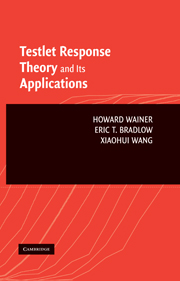Book contents
- Frontmatter
- Contents
- Preface
- PART I INTRODUCTION TO TESTLETS
- 1 Introduction
- 2 True score theory
- 3 Item response theory
- 4 What's a testlet and why do we need them?
- 5 The origins of testlet response theory – three alternatives
- 6 Fitting testlets with polytomous IRT models
- PART II BAYESIAN TESTLET RESPONSE THEORY
- PART III TWO APPLICATIONS AND A TUTORIAL
- Glossary of terms
- Epilogue
- Bibliography
- Author Index
- Subject Index
5 - The origins of testlet response theory – three alternatives
Published online by Cambridge University Press: 08 January 2010
- Frontmatter
- Contents
- Preface
- PART I INTRODUCTION TO TESTLETS
- 1 Introduction
- 2 True score theory
- 3 Item response theory
- 4 What's a testlet and why do we need them?
- 5 The origins of testlet response theory – three alternatives
- 6 Fitting testlets with polytomous IRT models
- PART II BAYESIAN TESTLET RESPONSE THEORY
- PART III TWO APPLICATIONS AND A TUTORIAL
- Glossary of terms
- Epilogue
- Bibliography
- Author Index
- Subject Index
Summary
As we mentioned earlier, the concept of the testlet was explicitly introduced by Wainer and Kiely (1987, p. 190) as “a group of items related to a single content area that is developed as a unit and contains a fixed number of predetermined paths that an examinee may follow.” In Chapter 4, we proposed the use of the testlet as the unit of construction and analysis for computerized adaptive tests (CATs) with the expectation that they could ease some of the observed and prospective difficulties associated with most current algorithmic methods of test construction. Principal among these difficulties are problems with context effects, item ordering, and content balancing.
We can summarize the way that testlets can help into two broad categories: control and fairness.
Control, in the sense that by redefining the fungible unit of test construction as something larger than the item, the test developer can recover some of the control over the structure of the finished test that was relinquished when it was decided to use an automatic test-construction algorithm.
Fairness, in the sense that all examinees who are administered a particular testlet, in addition to getting a sequence of items whose content and order have been prescreened and approved by a test developer and an associated test-development process, also get the same sequence as other examinees whose observed proficiencies are near theirs. Thus, when comparisons among examinees of very similar proficiency are made, those comparisons will be made on scores derived from tests of very similar content.
Since the introduction of testlets, a number of prospective uses have emerged. Some of these were foreseen in the original presentation, some were not.
- Type
- Chapter
- Information
- Testlet Response Theory and Its Applications , pp. 60 - 71Publisher: Cambridge University PressPrint publication year: 2007



